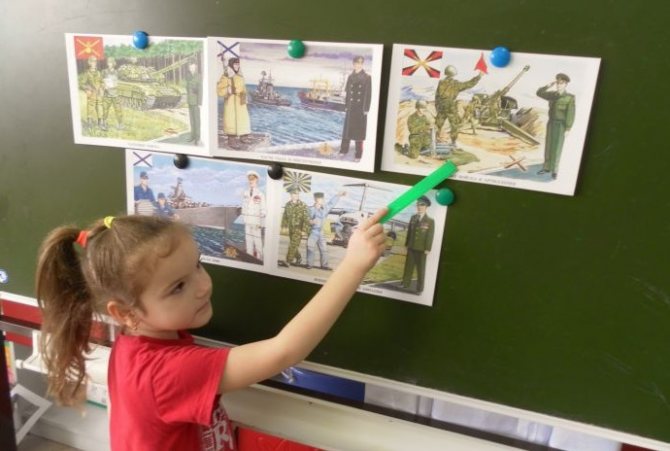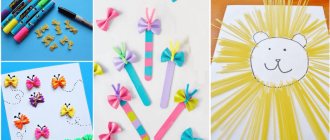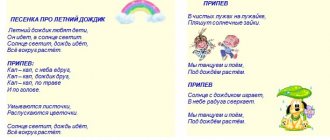Conducting an educational activity on drawing on a chosen topic (suitable topics for children 4–5 years old)
The availability of using non-traditional techniques is determined by the age characteristics of preschoolers. So, for example, you should start working in this direction with techniques such as drawing with your fingers, palm, tearing paper, etc., but in older preschool age these same techniques will complement the artistic image created using more complex ones: blotography, monotype. Here are several ways of drawing using non-traditional techniques.
How is GCD for drawing on a chosen topic carried out?
- Theme: “Autumn”
During the lesson you need to make prints of leaves and use gouache. This unconventional method teaches you to mix red and yellow gouache to create an orange color, and also to distinguish which tree is depicted on paper.
Self-education topics for educators
The following material is used for work: landscape sheet, fallen leaves from different trees (maple, birch, rowan, poplar, oak), gouache, wide brush, container with water, sheet of paper or oilcloth (place under the leaves to be painted).
During class, the teacher asks the children what leaves fall out. Then each child takes one leaf, places it with the smooth side on the oilcloth and paints the underside of the leaf with gouache of the same color. To get an orange leaf print, you need to teach children to mix red and yellow paints. While the gouache has not dried, the painted side of the leaf is applied to a clean sheet of paper and pressed tightly so that it is printed in its entirety. The leaf cannot be moved.
- The next topic of the week is “Dishes”
Drawing is done with cotton swabs. The teacher teaches children to draw a piece of utensils. A simple pencil is used for this. Children can independently select suitable colors and trace the outline with dots using a cotton swab with gouache.
For the lesson you need the following items: cup, plate, pan, ball, album sheets, simple pencils, cotton swabs, gouache, jars of water (for each child).
A selection of demonstration materials for the conversation (photos and drawings)
Before depicting a fictional character or object on paper, the teacher conducts a conversation with the children. The guys carefully look at the illustrations, study pictures with images that are interesting to them. The teacher places bright cardboard cards on the table on various topics, for example, “Spring”, “My City”, “New Year”, “Winter”, “Airplane”, “Where the birds fly for the winter”, “Snowman”, “Girl and Boy” ", "Winter Garden".
Music and poetry appropriate to the topic of the lesson
Drawing in the middle group is accompanied by cheerful melodies and poems. To begin with, the teacher prepares musical material:
- "Polyanka" - Russian folk music;
- “Lullaby” - A. Grechaninov;
- The play “Three Girlfriends” - D. Kabalevsky;
- Song “Winter” - M. Kartushina;
- Song “Two windows from the yard and a spreading maple”;
- Song “Sun through the leaves”;
- The game “It’s so cold, it’s frosty” is a Russian folk melody, arranged by I. Ponomareva.
Note! Before completing the work, the children begin to dance to the rhythm of the music. They must convey the mood of this composition in their movements.
Summary of a lesson on drawing in the chosen technique in the middle group (fragment in the form of a table)
| Topic of the week | Lesson notes | Material and method of conveying the idea |
| Body and face numbers | There are such boys | Drawing with a simple pencil |
| Vegetables | Cucumber tomato | Drawing with colored pencils |
| Fruits | Apple/pear | Brush, gouache |
| Berries | Cherry branch | Colour pencils |
| Birds | Dymkovo birds | Brush, gouache (team work) |
| Autumn | Autumn leaves | Fingerprints (gouache) |
| Pets | Kitty | Poking with a hard semi-dry brush (gouache) |
Conversations about art
Practical task: waxography
Topic 2.6. Means of expression of decorative and applied arts
Lesson 1
Introduction to the expressive means of decorative and applied art: the unity of usefulness and beauty. The most ordinary household items, such as dishes, can also be works of art and bring benefits. The material from which the object is made plays a big role: the softness, plasticity of clay, transparency and fluidity of glass, smoothness and coldness of the metal and how well the master conveyed these properties. Samples of Aegean ceramics, Gzhel, Venetian glass, vessels from Festus, Zhostovo trays, etc.
Lesson 2
Unity of form and material in dpi. DPI items can be decorated with paintings or stucco patterns, sculptures. The decoration must correspond to the shape of the item, its purpose and the material from which it is made. The master uses the natural properties of the material, for example, a duck ladle, a black-figure kylix, a red-figure amphora, Tagil painted trays, Chinese painted porcelain, Vologda lace, etc.
Topic 2.7 . Features of fine art materials
Lesson 1
Sculpture materials. Variety of sculptural materials. Granite is a hard, dense stone. The granite sculpture is distinguished by the integrity of its volume, its character is calm and stern. S. D. Merkurov monument to K. A. Timiryazev, portraits of famous people. Marble is a soft, slightly translucent stone. Sublime, spiritualized images are embodied in marble. Michelangelo's Pietà, works by Scopas, Praxiteles, Roman sculptural portraits. Clay is a plastic, docile material; models and sketches of sculptures are made from it. Fired clay with a rough surface – terracotta (Clodion “Girl with a Child”). Glazed clay with a smooth, shiny surface – earthenware (L. Dela Robbna “Boy with a Garland”). Bronze - strength, elasticity, flexibility and mobility of molten metal give the sculptor great opportunities for composition. "Poseidon" 5th century. BC e., Verrocchio “David”, Barry “The Panther and the Antelope”, E. M. Falconet monument to Peter I. Longitudinal fibers are always visible in the wood, and the lines along which the sculptor’s chisel moves and where they intersect, a sharp break in the form occurs. Therefore, a wood sculptor always takes this feature into account. Egyptian wooden sculptures – “Priest Amenhotep”, “Scribe Kaya”; V. I. Mukhin’s portrait of academician A. N. Krylov, S. T. Konenkov “Old Field Man”.
Lesson 2
Variety of artistic painting materials. The choice of material depends on the artist’s intention. If an artist paints a picture directly on a wall, he often chooses the fresco technique. Paints for this type of work are diluted with water and applied to wet plaster. This painting is very durable and looks natural and beautiful on the wall. Raphael, Stanzas; Michelangelo, fragments of the Sistine Chapel painting. Before the oil painting technique, artists painted on boards with paints to which they added eggs or plant juices. Such paints are called tempera. A. Rublev “Trinity”; icon of the Rostov-Suzdal school of the 16th century. “The Miracle of Dmitry of Thessalonica; Simone Martini "The Annunciation". The development of oil painting techniques is associated with the names of the Van Eyck brothers, Dutch painters of the 15th century. Oil can be used for both quick sketches and longer works. The surface of the painting can be smooth (F. Vasiliev “Wet Meadow”), or it can be rough and uneven (M. Vrubel “Girl against the background of a Persian carpet”; C. Monet “Rouen Cathedral.” Individual strokes can merge or imperceptibly transform into friend (T. O. D. Ingres “Self-Portrait”), or can be clearly visible (Van Gogh “Road in Provence”) The effect of a space filled with light and air in oil technique is well conveyed by I. I. Shishkin “Noon. vicinities of Moscow", and real tangible objects in J.-B. Chardin's "Still Life".
Examples of finished works, photo gallery
Here are several finished works with topics interesting for kids:
- "Winter Fun"
Children learn to convey the features of the depicted object using an imprint with crumpled paper. The guys draw the desired image (Snow Maiden) using a brush. As a material, you can use blue cardboard, a container with white gouache, slightly diluted with water, medium-sized lumps of crumpled paper, gouache, brushes, jars of water.

Examples of work with photography
The teacher invites the children to draw a friend for the snow woman in an unusual way - with crumpled paper.
Next, the teacher shows how crumpled paper is lowered into a saucer with white paint and placed several times at the bottom of the cardboard, depicting a round ball. Then draw a small ball in the same way. When the paint dries, you need to finish painting the snow woman’s eyes, carrot nose, and twig hands.
- "Defender of the Fatherland Day»
The guys create a drawing for the holiday using a brush on a wet sheet of paper. Next comes an introduction to a new technique of drawing on a damp sheet of paper. They choose a beautiful paint color to create the desired look. The materials used are paper, watercolors, a brush, a container of water, and napkins.
The teacher invites the children to draw fireworks in honor of the holiday. First, you need to apply water to the landscape sheet with a wide brush. Then put watercolor paint on a thin brush and touch it to a sheet of paper in several places. The dots will begin to spread out. The empty spaces need to be filled with spreading dots of other colors.
Theme for drawing “Defender of the Fatherland Day” in the middle groups of preschool educational institutions
Note! Make sure that children rinse the brush thoroughly in water.

